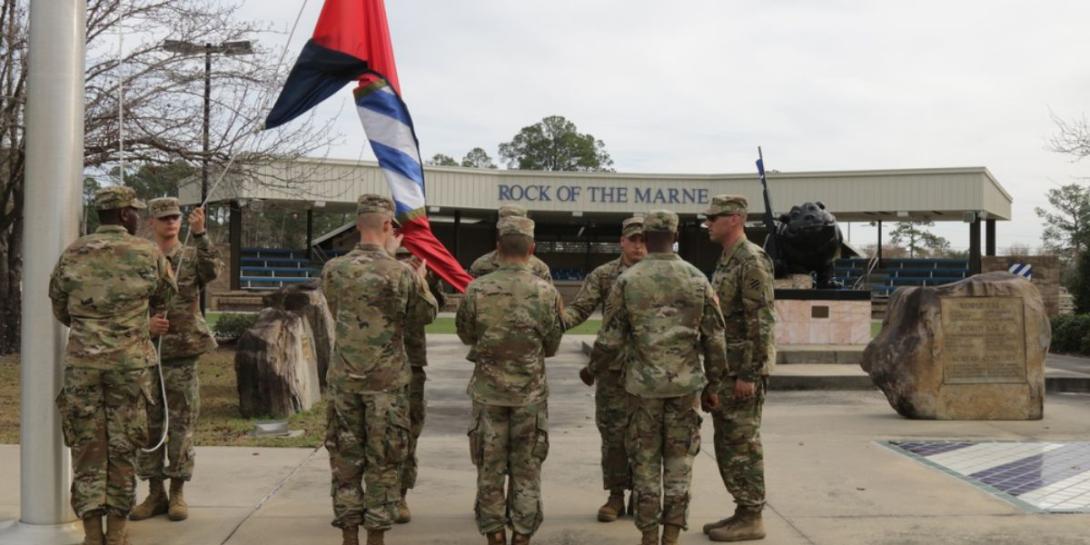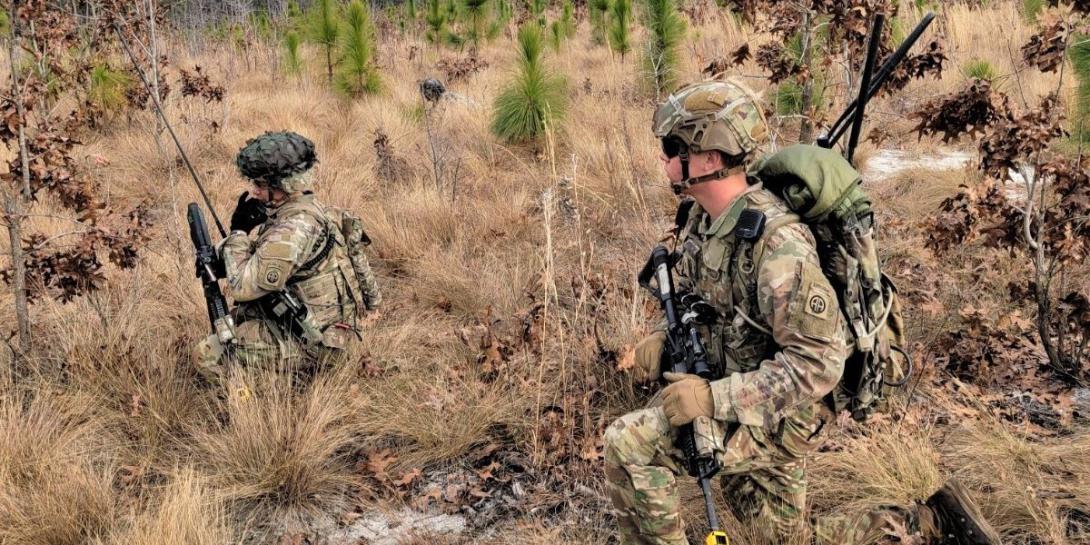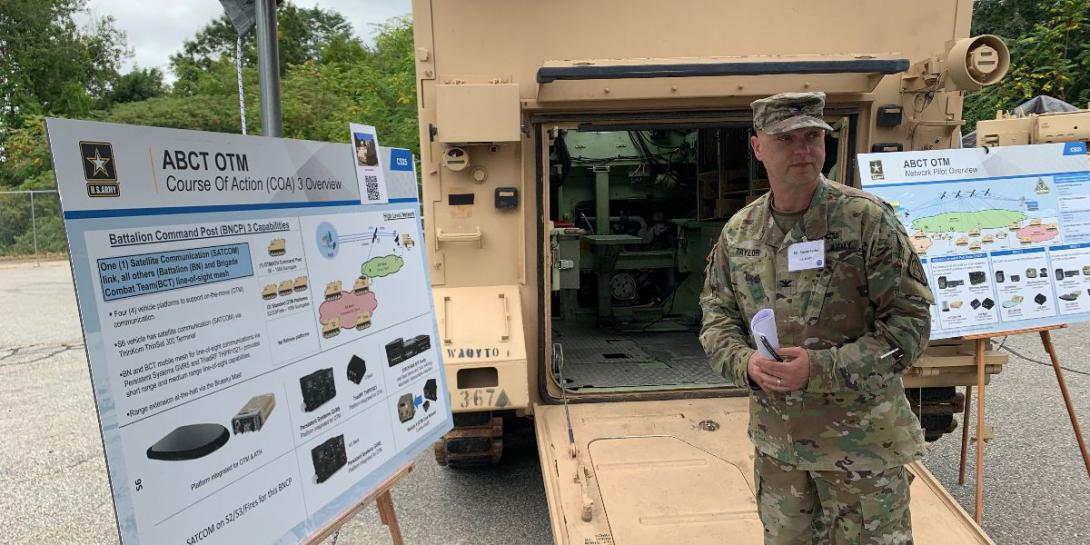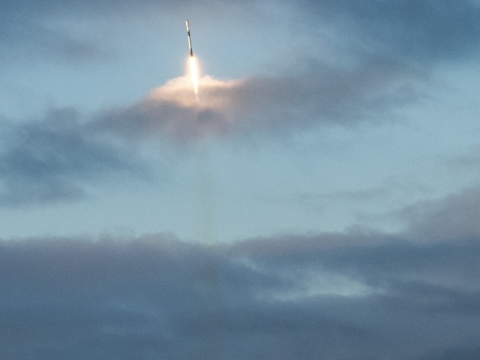Army Hones On-the-Move Communications
Last month, 16 armored vehicles arrived at Fort Stewart, Georgia, specially equipped with a range of commercial communications technologies. The vehicles are part of the U.S. Army’s Armored Brigade Combat Team On-The-Move network pilot program, led by the Program Executive Office Command, Control, Communications-Tactical. Leveraging commercial gear, the Army is conducting the pilot to identify what kinds of communications and network technologies could successfully be applied to moving armored vehicles to support soldiers in a contested, near-peer environment.
The work is part of the Program Executive Office Command, Control, Communications-Tactical’s, or PEO C3T’s, Capability Set 2025 (CS25) iterative effort to harness industry innovation and add tactical communication solutions in two-year sprints. PEO C3T and the Army’s Network Cross-Functional Team (N-CFT) are hosting an industry forum this month in Nashville to continue the design discussions for CS25, focusing on armored brigade combat team (ABCT) networking; data management; standards and open architecture; and platform integration. PEO C3T and the N-CFT are currently implementing CS21 and CS23.
The ABCT On-The-Move network pilot program is meant to inform CS25. The program is an early look at possible concept of operations (CONOPS) and how to most effectively distribute communications capabilities in various configurations across a group of armored vehicles and solider roles. The goal is to provide full communication capabilities—including line-of-sight and beyond line-of-sight solutions—to soldiers in maneuver platforms. The Army aims to increase soldier survivability, enhance communications, enable a more resilient network and provide greater throughput for data, explains Col. Shane Taylor, USA, project manager, Tactical Network, PEO C3T.
“Let me start with what it is not,” Col. Taylor states. “The pilot is not intended to be a material selection, a down select. That is key to this. You’re going to see a list of vendors that are partnering with us on this effort; however, if a vendor is not on there, it does not mean they are not moving forward. This is an opportunity to look at a variety of technologies across maturity levels. And then from a CONOPS perspective, it is looking at how we would employ the kit, how we would execute the kit. It is an opportunity to get after that.”
The pilot is testing commercial satellite communication (SATCOM) terminals; very small aperture terminals (VSAT); Ku-Band flat panel SATCOM on-the-move terminals (SOTM); waveforms; modems; routing and switching; antenna masts; mesh radios; network architectures; a tethered drone; and ruggedized power solutions.
Twelve M-1068s are standing in as surrogates for future armored vehicles that could receive whichever technology dispersions are selected for CS25. In addition, the pilot involves four high-mobility multipurpose wheeled vehicles, or Humvees.
In addition to PEO C3T and the N-CFT, soldiers from III Corps (Fort Hood), the 3rd Infantry Division and the 82nd Airborne and other personnel are all helping to inform the pilot program. The warfighters will look at how easy the technologies are to use, if the designs are soldier-centric, actually aid operations, have favorable size, weight and power considerations and offer affordability, Col. Taylor notes.
“Probably the biggest fundamental difference is that real-time feedback,” the colonel explains. “In the past, there was this two- to three-year development of requirements that would be thrown over the fence to the PEO community. We’d work with vendors in a developmental effort, and a couple of years later, what came out of the pipe was a capability. And the first time that soldiers would see the technologies would be at a user jury or user test. We’ve kind of flipped the script now. With the ABCT pilot, you are going to get the kit in the hands of soldiers early and get real-time feedback. Then we use that to actually shape and inform the requirements. We are trying to let the technology drive the requirements. And it helps us to understand what is out there.”
The effort is pulling in technologies from two dozen commercial companies. General Dynamics Mission Systems, the contract prime and lead integrator, installed the gear into the 16 vehicles this fall at their Area 53 outdoor facility in Taunton, Massachusetts, relying on their expertise and hundreds of mechanical and electrical drawings, shares Edward Reber, program director, Combat Platforms, General Dynamics Mission Systems.
“It’s the technology that is commercially available today that we are working with to figure out how to get it mounted, how to apply it, and how to use it in a tactical environment,” Reber states.
The company hosted an open house at the Taunton facility for Army leaders on September 21 and for the media a day later. In late October, army officials began conducting safety assessments on the vehicles at Aberdeen Proving Ground, Maryland, with shipment of the vehicles to Fort Stewart in mid-November. This month, the vendors will begin risk-reduction efforts and network testing of their equipment on the armored vehicles. Soldiers will begin employing the technologies on the armored vehicles in maneuver and operating scenarios at Fort Stewart between January 24 and February 11, 2022.
PEO C3T plans to report the results of the pilot by June 2022, providing information and tactical data to help inform the actual technology selection needed for Armored Brigade Combat Teams to be deployed as part of CS25.
Col. Taylor stresses that the technologies from the 24 or so vendors are only being considered and may not be what the Army ultimately prefers or what is ready for use on armored vehicles. In addition, the courses of action, and how the technologies are arranged and used in formation across each vehicle or in a group of vehicles, may change.
“We need to also look at operational relevance, how this equipment is used, where it’s used, who it’s used by, how difficult the training is behind it—all of those aspects,” adds Paul Mehney, director, Public Communications, PEO C3T. “And it is now not just the Army that is looking at that, and it is the Army, the industry and the user community, altogether tackling those challenges. It is a more complex issue, but now the business practices behind it are facilitating the ability to field new technology every two years.”
In addition, the pilot will help inform the Army’s armored vehicle development, including with the Ground Vehicle Systems Center in Michigan. Mehney says PEO C3T officials are “working hand in hand with the Detroit community” to coordinate safety standards and common network architecture.
Specifically, the program is testing three different network combinations: SATCOM and line of sight; SATCOM only; and line of sight only. Mesh radios and waveforms solutions are being considered from Persistent Systems (GVR5), Silvus Technologies (SC-4480E) and Triad (THPR-1021), as well as three possible height approaches; an unmanned aerial vehicle (UAV) from Hoverfly and antenna masts from Fireco and BlueSky—to extend line-of-sight network ranges.
For mounted beyond line-of-sight capabilities, the Army is considering SATCOM from GetSat, two flat panel broadband satellite-on-the-move terminals from Kymeta and ThinKom, and waveforms from NCW (already in use in tactical settings), iDirect and LinkWay satellite terminals.
It will be the first time the Army has installed on an armored vehicle a mounted beyond line-of-sight capability using the flat panel terminals from Kymeta and ThinKom. It will be a test of the emerging technologies’ ruggedness.
“Flat panel is a technology that we definitely want to leverage,” Col. Taylor shares. “It is still somewhat immature [for the military’s use on armored vehicles], because of the sheer size of it.”
Other vendor solutions that the Army is considering include ViaSat’s CBM-400 software-defined modem to connect to LinkWay’s terminal; L3 Harris’ MPM-1000 and 2000 modems to connect to NCW; iDirect’s 9050 OM modem to connect to its terminal; Curtiss-Wrights’ ruggedized routing and switching devices; Cubic/Dtech Labs’ M3X family of SFF solutions; SCI TOCNET-G4 VOIP/ROIP devices; and GMS’ ruggedized housing. General Dynamics also is providing its ED3 PNT/APNT hub, rugged armored vehicle network kit and encryption devices.
The Army is experimenting with different configurations of the technology, designing three groupings of four vehicles. The first, also known as Battalion Command Post (BNCP) 1, represents the most robust platform of capabilities arranged to form a highly resilient network. The communications solutions, which are also meant to improve Joint Network Node capability and mobility, are fully distributed across the four BNCP 1 vehicles. The grouping includes SATCOM and a battalion and brigade combat team (BCT) line-of-sight mesh network.
In addition, for BNCP 1, the Army also is looking at five different VSATs from Airbus, AvL Technologies, DataPath, L3Harris and GigaSat, to replace its legacy Satellite Transportable Terminal system, which is currently deployed via trailer. (See related sidebar.)
For the solutions housed in the communications vehicle, for S6 soldiers, the baseband solution is mountable and dismountable, and the NCW mobile satellite communication is a small form factor, gimbaled option. The S6 arrangement in BNCP 1 also includes Hoverfly’s UAV and the possible VSAT capabilities. Meanwhile, the three vehicles for intelligence (S2), operations (S3) and fires will house a baseband capability that is ruggedized, with radio tray integration. The line-of-sight mesh network includes an S and C Band mesh network for battalions and C Band for the BCTs.
“In BNCP 1, we actually have a SATCOM terminal on each of the vehicles, as well as line-of-sight capability,” says Reber. “It is a heavy line-of-sight network between the vehicles, using the Silvus technology. Whereas in some of the other [BNCPs], like in BNCP 3, what you’ll notice is that the S6 is the gateway from the formation or the battalion, back into the network and the brigade level.”
For the second grouping of vehicles and technologies (BNCP 2), the S2, S3 and fires vehicles will only have a satellite communications solution. Here, the Army is considering the Kymeta’s flat panel terminal with iDirect’s waveform, with the terminal mounted on all four vehicles, including the S6. The S6 would also house a mounted and dismounted baseband capability, an S and C Band mesh network for battalions and C Band for the BCTs.
In the third grouping, BNCP 3, the service will examine having only a line-of-sight solution for the S2, S3 and fires vehicles, with satellite communications on the S6 vehicle—ThinKom’s ThinSat 300 satellite on-the-move terminal with LinkWay’s waveform.
“We’re just trying out various commercial solutions so that the Army can ascertain how they perform in the tactical environment and make some informed decisions about whether it’s good enough with some tweaks, or whether it’s not going to be good enough in a tactical environment,” Reber says.






Comments